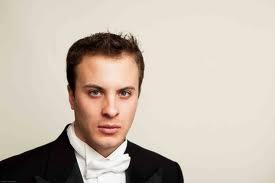Here’s another example of classical music entrepreneurship. Plus some work I did, that now is showing some results.
I was delighted when I went to hear the University of Maryland Symphony Orchestra on Friday, and found a larger, younger, and more lively audience than I’d ever seen at these concerts.
The concert also was dramatically good (speaking musically, now), way beyond what anyone would normally expect of a student orchestra. More on that in another post
And of course I was curious to know how this audience had gotten there. When I became artist in residence at the university in 2009, the UMSO concerts (U of Maryland Symphony Orchestra) were musically terrific, but otherwise were sleepy affairs, with half-full houses, and a loyal but very quiet older audience. Very few students, even music students, seemed to be there.
My gig, as artist in residence, was to work with the students, to help them find an audience their own age. And we had some preliminary success, as I blogged at the time. By personally inviting students who played classical instruments — and by giving them free tickets — we could get a couple of hundred new people at concerts by the Symphony Orchestra and the Wind Orchestra.
But following up on that was difficult. Now we needed hard, sustained work, contacting people who’d already come, for instance, and trying to get them to come again, or else finding new ways to reach out to new people. The students had some good ideas, but couldn’t always implement them, because — understandably — their schedules were already very busy.
So what happened this year, to bring new people to the concert? John Devlin, a DMA student in conducting at the university, was put in charge of what the Symphony Orchestra calls its New Lights program, which up to now has largely been about making concerts more personal, and friendlier. The students (just for instance) wear black onstage, but accessorize with accent colors, which are picked to fit the music (blue and green for Mahler’s Fourth Symphony last year, red for The Miraculous Mandarin last Friday). And statements by them — personal, direct, and full of life — are posted outside the concert hall.
What John added, as he told me, grew from seeds he said I planted while I was in residence. The students now are getting organized. Things are at an early stage, but they’re finding ways to reach other students that they come in contact with — at their dorms, for instance, or in classes. Each dorm could have a Symphony ambassador, who’d coordinate efforts to talk to students living there about upcoming concerts. Every music class was targeted.
And the results — even at an early stage — spoke for themselves. This was a renewed audience. Lively, fresh, enthusiastic. Bravo, everyone. And I’m very flattered by the credit I was given, not just by John, but by others. So I’ll turn it around. Everyone involved deserves far more praise. I may have planted the seeds, but they had the ideas. And did the work.
Credit also goes to Robert Gibson, the dean of the University of Maryland School of Music, who brought me in. And — in vast, vast quantities — to James Ross, the head of the conducting program and conductor of the Symphony Orchestra, who started New Lights, and provides the continuing inspiration and authority it needs to keep going.
Jim also is the reason why the concerts are so good, though if I know him, he’d give more credit to the students, which is one of many reasons why he’s special. He and I now overlap at two institutions, since he’s now Associate Director of Conducting Studies at Juilliard, working closely with Alan Gilbert, who runs the conducting program there.

